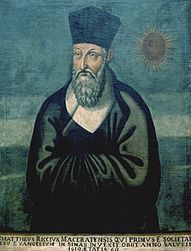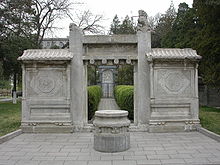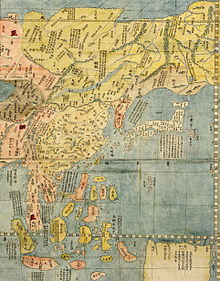- Matteo Ricci
-
Matteo Ricci
Servant of God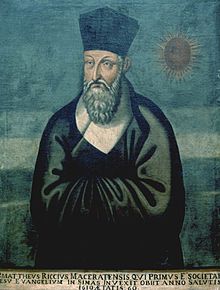
Born 6 October 1552
 Macerata, Papal States
Macerata, Papal StatesDied 11 May 1610 (aged 57)
Beijing, Ming EmpireEthnicity Italian Alma mater Society of Jesus Influenced by Alessandro Valignano, Christopher Clavius Successor Nicholas Longobardi Religion  Catholic
CatholicMatteo Ricci Traditional Chinese 利瑪竇 Simplified Chinese 利玛窦 Transcriptions Mandarin - Hanyu Pinyin Lì Mǎdòu - IPA [lɨ̂ mɑ̀tôʊ] Alternative Chinese name Traditional Chinese 西泰 Simplified Chinese 西泰 Transcriptions Mandarin - Hanyu Pinyin Xītài Cantonese (Yue) - IPA [ɕɨ́tʰâɪ] Matteo Ricci, SJ (October 6, 1552 – May 11, 1610; simplified Chinese: 利玛窦; traditional Chinese: 利瑪竇; pinyin: Lì Mǎdòu; courtesy name: 西泰 Xītài) was an Italian Jesuit priest, and one of the founding figures of the Jesuit China Mission, as it existed in the 17th-18th centuries. His current title is Servant of God.
Contents
Early life
Matteo Ricci was born in 1552 in Macerata, part of the Papal States, and today a city in the Italian region of Marche . Ricci started learning theology and law in a Roman Jesuit school. He entered the order in 1571, and in 1577 he applied for a missionary expedition to India. His journey began in March 1578 in Lisbon, Portugal. He arrived in Goa, a Portuguese Colony, in September 1578. Four years later, he was dispatched to China.
Ricci in China
In August 1582, Ricci arrived at Macau, a Portuguese trading post on the South China Sea. At the time, Christian missionary activity in China was almost completely limited to Macau, where some of the local Chinese people had converted to Christianity and lived in the Portuguese manner. No Christian missionary had attempted seriously to learn the Chinese language until 1579 (three years before Ricci's arrival), when Michele Ruggieri was invited from Portuguese India expressly to study Chinese, by Alessandro Valignano, founder of St. Paul Jesuit College (Macau), and to prepare for the Jesuits' mission from Macau into Mainland China.[1]
Once in Macau,, Ricci started learning Chinese language and customs. This was the beginning of a long project that made him one of the first Western scholars to master Chinese script and Classical Chinese. With Ruggieri, he traveled to Guangdong's major cities, Canton and Zhaoqing (then the residence of the Viceroy of Guangdong and Guangxi), seeking to establish a permanent Jesuit mission outside Macau.
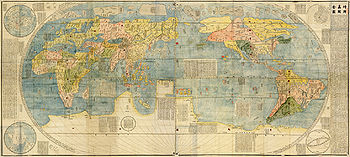 Unattributed, very detailed, two page colored edition (1604?), copy of the 1602 map with Japanese katakana transliterations of the phonetic Chinese characters
Unattributed, very detailed, two page colored edition (1604?), copy of the 1602 map with Japanese katakana transliterations of the phonetic Chinese characters
In 1583, Ricci and Ruggieri settled in Zhaoqing, at the invitation of the governor of Zhaoqing, Wang Pan, who had heard of Ricci's skill as a mathematician and cartographer. Ricci stayed in Zhaoqing from 1583 to 1589, when he was expelled by a new viceroy. It was in Zhaoqing, in 1584, that Ricci composed the first European-style map of the world in Chinese, now called the "Impossible Black Tulip"[2] after its rarity. No prints of the 1584 map survive, but six re-copied, rice-paper versions survive from 1602.[3]
It is thought that, during their time in Zhaoqing, Ricci and Ruggieri compiled a Portuguese-Chinese dictionary, the first in any European language, for which they developed a system for transcribing Chinese words in the Latin alphabet. The manuscript was misplaced in the Jesuit Archives in Rome, not re-discovered until 1934, and published until 2001.[4][5]
There is now a memorial plaque in Zhaoqing to commemorate Ricci's six-year stay there, as well as a "Ricci Memorial Centre"[6], in a building dating from the 1860's.
Expelled from Zhaoqing in 1589, Ricci obtained permission to relocate to Shaoguan (Shaozhou, in Ricci's account) in the north of the province, and reestablish his mission there.[7]
Further travels saw Ricci reach Nanjing and Nanchang in 1595. In August 1597, Alessandro Valignano (1539–1606), his superior, appointed him Major Superior of the mission in China, with the rank and powers of a Provincial, a charge that he fulfilled until his death.[8] He moved to Tongzhou (a port of Beijing) in 1598, and first reached Beijing itself on 7 September 1598. However, because of a Korean/Japanese war at the time, Ricci could not reach the Imperial Palace. After waiting for two months, he left Beijing; first for Nanjing and then Suzhou in Jiangsu Province.
During the winter of 1598, Ricci, with the help of his Jesuit colleague Lazzaro Cattaneo, compiled another Chinese-Portuguese dictionary, in which tones in Chinese syllables were indicated in Roman text with diacritical marks. Unlike Ricci's and Ruggieri's earlier Portuguese-Chinese dictionary, this work has not been found.[4]
In 1601, Ricci was invited by the Emperor to become an adviser to the Imperial court of the Wanli Emperor; the first Westerner to be invited into the Forbidden City. This honour was in recognition of Ricci's scientific abilities, chiefly his predictions of solar eclipses, which were significant events in the Chinese world.[9] He established the Cathedral of the Immaculate Conception in Beijing, the oldest Catholic church in the city.[10] Ricci was given free access to the Forbidden City, but he never met the reclusive Wanli Emperor. Wanli did grant him patronage, however, with a generous stipend.
Once established in Beijing, Ricci was able to meet important officials and leading members of the Beijing cultural scene, and convert a number of them to Christianity. One conversion, which he called "extraordinary", occurred in 1602, when Li Yingshi, a decorated veteran of the Japanese/Korean War and a well-known astrologer and feng shui expert, became a Christian. This man provided the Jesuits with a wealth of information useful in communicating with the "heathens."[11][12]
Ricci was also the first European to learn about the Kaifeng Jews.[13], being contacted by a member of that community who was visiting Beijing in 1605. Ricci never visited Kaifeng, Henan Province, but he did send a junior missionary there in 1608, the first of many such missions. In fact, the elderly Chief Rabbi of the Jews was ready to cede his power to Ricci, as long as he gave up eating pork, but he never accepted the position.[13]
Ricci died in Beijing on May 11, 1610, at 58. By the code of the Ming Dynasty, foreigners who died in China had to be buried in Macau. Diego de Pantoja made a special plea to the court, requesting a burial plot in Beijing, in the light of Ricci's contributions to China. Emperor Wanli granted this request and designated a Buddhist temple for the purpose. In October 1610, Ricci's remains were transferred there.[14] The graves of Ferdinand Verbiest, Johann Adam Schall von Bell, and other missionaries are also there, and it became known as the Zhalan cemetery (Chinese: 栅栏墓地; pinyin: Zhàlán Mùdì). It is now part of the campus of Beijing Administrative College (located at 6 Chegongzhuang Road, Xicheng District, Chinese: 西城区车公庄大街6号; pinyin: Xīchéng Qū Chēgōngzhuāng Dàjiē 6Hào).
Matteo Ricci was succeeded as Superior General of the China mission by Nicolò Longobardo, in 1610. Longobardo entrusted another Jesuit, Nicolas Trigault, with expanding and editing, as well as translating into Latin, those of Ricci's papers that were found in his office after his death. This work was first published in 1615 in Augsburg as De Christiana expeditione apud Sinas, and soon was translated into a number of other European languages.[15]
Ricci's approach to Chinese culture
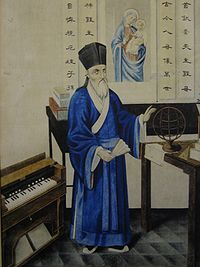 Matteo Ricci dressed in traditional Chinese robes.
Matteo Ricci dressed in traditional Chinese robes.
Ricci could speak Chinese as well as read and write classical Chinese, the literary language of scholars and officials. He was known for his appreciation of Chinese culture in general, but did condemn the prostitution which was widespread in Beijing at the time.[16] During his research he discovered that, in contrast to the cultures of South Asia, Chinese culture was strongly intertwined with Confucian values and therefore decided to use existing Chinese concepts to explain Christianity. He did not explain the Catholic faith as something foreign or new, instead, he said that the Chinese culture and people always believed in God, and that Christianity is simply the most perfect manifestation of their faith.[17] Thus the Chinese Lord of Heaven (天主) is identical with God. He supported Chinese traditions by agreeing with the veneration of the dead. Dominican and Franciscan missionaries felt he went too far in accommodation and convinced the Vatican to outlaw Ricci’s approach.[18][19] Similarly to developments in India, the identification of European culture with Christianity led to the virtual end of Catholic missions in China.[18]
Later discovering that Confucian thought was dominant in the Ming Dynasty, Ricci became the first to translate the Confucian classics into a western language, Latin, with assistance from the scholar Xu Guangqi.
Ricci also met a Korean emissary to China, Yi Su-gwang. He taught Yi Su-gwang the basic tenets of Catholicism and transmitted western knowledge to him, giving Yi Su-gwang several books from the west which were incorporated in Jibong yuseol, which was the first Korean encyclopedia.[20] Ricci's transmission of western knowledge to Yi Su-gwang influenced and helped shape the foundation of the Silhak movement in Korea.[21]
Cause of Canonization
The cause of beatification of Father Matteo Ricci (1552–1610), originally begun in 1984, was reopened on January 24, 2010 at the cathedral of the east-central Italian Diocese of Macerata-Tolentino-Recanati-Cingoli-Treia.[22][23]
Commemoration
The following places and institutions are named after Matteo Ricci:
- Matteo Ricci Pacific Studies Reading Room at The National Central Library of Taiwan
- Ricci Hall, a dormitory at The University of Hong Kong
- Ricci Building, a building at Wah Yan College, Kowloon in Hong Kong
- The Matteo Ricci Study Hall, at the Ateneo de Manila University
- Matteo Ricci College, Kowloon in Hong Kong
- Matteo Ricci College at Seattle University
- Colégio Mateus Ricci, Macau
- Sekolah Katolik Ricci in Pancoran, Indonesia
- Taipei Ricci Institute, Taiwan
- Macau Ricci Institute, Macau[24]
- Ricci Institute for Chinese-Western Cultural History at the University of San Francisco.
- The Matteo Ricci Society at Fordham University
- Matteo Ricci Hall-"R" Hall, Ricci Hall Annex-"RA" Hall two buildings at Sogang University in Seoul, South Korea
- Townhouse block #14 at Fairfield University
In the run-up to the 400th anniversary of Ricci's death, the Vatican hosted a major exhibit dedicated to his life. At least one Catholic bishop - Claudio Giuliodori from Ricci's hometown, Macerata - has mentioned that the possibility of the Jesuit's beatification is considered by the church authorities.[25] Additionally, Italian film director Gjon Kolndrekaj produced a 60 minute documentary about Ricci that came out in 2009, entitled "Matteo Ricci: A Jesuit in the Dragon's Kingdom", filmed in both Italy and China.[26][27] Also, in Taipei, the Taipei Ricci Institute and the National Central Library of Taiwan opened jointly the "Matteo Ricci Pacific Studies Reading Room"[28] and the Taipei-based online magazine eRenlai, directed by Jesuit Benoît Vermander dedicated its issue of June 2010 to the commemoration of the 400th anniversary of Ricci's death[29]
The True Meaning of the Lord of Heaven
The True Meaning of the Lord of Heaven is a book written by Matteo Ricci, which argues that Confucianism and Christianity are not opposed and in fact are remarkably similar in key ways. Ricci used this treatise in his missionary effort to convert Chinese literati, men who were educated in Confucianism and the Chinese classics. There was controversy over whether Ricci and other Jesuits had gone too far and changed Christian beliefs in order to win converts.
See also
- Religion in China
- Christianity in China
- Jesuit China missions
- List of Jesuit scientists
- List of Roman Catholic scientist-clerics
- List of Roman Catholic missionaries in China
- History of the Jews in China
- 19th Century Protestant Missions in China
- List of Protestant missionaries in China
- Horses in East Asian warfare
- Zhang Dai
- Kunyu Wanguo Quantu
- Diego de Pantoja
Notes
- ^ Gallagher (trans) (1953), pp. 131-132, 137
- ^ Baran, Madeleine (December 16, 2009). "Historic map coming to Minnesota". St. Paul, Minnesota.: Minnesota Public Radio. http://minnesota.publicradio.org/display/web/2009/12/16/tulip-map/. Retrieved 12 January 2010.
- ^ "Ancient map with China at centre goes on show in US". BBC News. January 12, 2010. http://news.bbc.co.uk/1/hi/world/asia-pacific/8454049.stm.
- ^ a b Yves Camus, "Jesuits’ Journeys in Chinese Studies"
- ^ "Dicionário Português-Chinês : 葡汉辞典 (Pu-Han cidian): Portuguese-Chinese dictionary", by Michele Ruggieri, Matteo Ricci; edited by John W. Witek. Published 2001, Biblioteca Nacional. ISBN 9725652983. Partial preview available on Google Books
- ^ Ricci Memorial Centre
- ^ Gallagher (253), pp. 205-227
- ^ Dehergne, 219.
- ^ Chan Kei thong. Faith of Our Father, China Publishing Group Orient Publishing Centre, Shanghai China
- ^ (Chinese) "The Tomb of Matteo Ricci" Beijing A Guide to China's Capital City Accessed 2010-10-05
- ^ Gallagher (trans) (1953), pp. 433-435
- ^ Engelfriet, Peter M. (1998), Euclid in China: the genesis of the first Chinese translation of Euclid's Elements, books I-VI (Jihe yuanben, Beijing, 1607) and its reception up to 1723, BRILL, p. 70, ISBN 9004109447, http://books.google.com.au/books?id=aKLr5duAiwMC
- ^ a b White, William Charles. The Chinese Jews. New York: Paragon Book Reprint Corporation, 1966
- ^ The Tomb of Matteo Ricci
- ^ Mungello, David E. (1989). Curious Land: Jesuit Accommodation and the Origins of Sinology. University of Hawaii Press. pp. 46–48. ISBN 0824812190. http://books.google.com/books?id=wb4yPw4ZgZQC..
- ^ Hinsch, Bret. (1990). Passions of the Cut Sleeve. Published by the University of California Press. p. 2
- ^ August Franzen, Kirchengeschichte, Freiburg,1988, 323
- ^ a b Franzen 324
- ^ See Wikipedia article, Chinese Rites controversy
- ^ National Assembly, Republic of Korea: Korea History
- ^ Bowman, John S. (2000). Columbia Chronologies of Asian history and Culture, p. 212.
- ^ Father Matteo Ricci’s beatification cause reopened
- ^ Diocese to re-launch beatification cause for missionary Fr. Matteo Ricci
- ^ The Macau Ricci Institute 澳門利氏學社
- ^ Vatican hosts Matteo Ricci exhibition
- ^ A Jesuit in the dragon's kingdom
- ^ [1] Interview with Gjon Kolndrekaj
- ^ Remembering Ricci: Opening of the Matteo Ricci - Pacific Studies Reading Room at the National Central Library - www.eRenlai.com
- ^ June 2010 - www.eRenlai.com
References
- Dehergne, Joseph, S.J. (1973). Répertoire des Jésuites de Chine de 1552 à 1800. Rome: Institutum Historicum S.I. OCLC 462805295
- Hsia, R. Po-chia. (2007). "The Catholic Mission and translations in China, 1583–1700" in Cultural Translation in Early Modern Europe (Peter Burke and R. Po-chia Hsia, eds.). Cambridge: Cambridge University Press. 13-ISBN 9780521862080/10-ISBN 0521862086; OCLC 76935903
- Spence, Jonathan D.. (1984). The Memory Palace of Matteo Ricci. New York: Viking. 10-ISBN 0670468304/13-ISBN 9780670468300; OCLC 230623792
Further reading
- Cronin, Vincent. (1955). The Wise Man from the West: Matteo Ricci and his Mission to China. (1955) OCLC 664953
- Gernet, Jacques. (1981). China and the Christian Impact: a conflict of cultures. Cambridge: Cambridge University Press. 10-ISBN 0521313198/13-ISBN 9780521313193; OCLC 21173711
- Simon Leys, Madness of the Wise : Ricci in China, an article from his book, The Burning Forest (1983). This is an interesting account, and contains a critical review of The Memory Palace by Jonathan D. Spence.
- Mao Weizhun, « European influences on Chinese humanitarian practices. A longitudinal study » in : Emulations - Journal of young scholars in Social Sciences, n°7 (June 2010).
- World Digital Library presentation of 職方外紀 六卷卷首一卷 or "Chronicle of Foreign Lands", 1623. Library of Congress. This book explains Matteo Ricci's world map of 1574.
Resources
Works
- De Christiana expeditione apud Sinas: the journals of Ricci that were completed and translated into Latin by another Jesuit, Nicolas Trigault, soon after Ricci's death. Available in various editions:
- Trigault, Nicolas S. J. "China in the Sixteenth Century: The Journals of Mathew Ricci: 1583-1610". English translation by Louis J. Gallagher, S.J. (New York: Random House, Inc. 1953).
- On Chinese Government, an excerpt from Chapter One of Gallagher's translation.
- De Christiana expeditione apud Sinas, full Latin text, available on Google Books
- A discourse of the Kingdome of China, taken out of Ricius and Trigautius, containing the countrey, people, government, religion, rites, sects, characters, studies, arts, acts; and a Map of China added, drawne out of one there made with Annotations for the understanding thereof (an early English translation of excerpts from De Christiana expeditione) in Purchas his Pilgrimes (1625). Can be found in the full text of "Hakluytus posthumus" on archive.org. The book also appears on Google Books, but only in snippet view.
- An excerpt from The Art of Printing by Matteo Ricci
- Ricci's World Map of 1602
- Rare 1602 World Map, the First Map in Chinese to Show the Americas, on Display at Library of Congress, Jan. 12 to April 10 2010
External links
- World Digital Library presentation of 職方外紀 六卷卷首一卷 or "Chronicle of Foreign Lands", 1623. Library of Congress. This book explains Matteo Ricci's world map of 1574.
- Fairfield University: Matteo Ricci, S.J.
- University of Scranton: Matteo Ricci, S.J.
- A timeline of Matteo Ricci in China
- The Zhaoqing Ricci Center
- Article about the tomb of Matteo Ricci in Beijing
- Catholic Encyclopedia: Matteo Ricci
- Ricci Institute for Chinese-Western Cultural History
- Rotary Club Macerata Matteo Ricci (in Italian)
- Lamberto Bozzi: The Matteo Ricci Macerata Project
- Lamberto Bozzi: Pinocchio in China/Pinocchio nella Cina (In English and Italian)
- Matteo Ricci moves closer toward beatification
Christianity in China Chinese terms for God 
Foundations Chinese Bible translations Assyrian Church of the East Medieval Roman Catholic
missionsJesuit missions Francis Xavier · Matteo Ricci · St. Paul Jesuit College (Macau) · Chinese Rites controversy · Joachim BouvetProtestant missions Important figures Religious freedom
in the PRCEvents Taiping Rebellion · First Opium War · Second Opium War · Unequal treaty · Yangzhou riot · Tianjin Massacre · Boxer Crisis · Anti-Christian Movement · Xinhai Revolution · Chinese Civil War · WW II · People's RepublicImpact Science and technology · Medical missions in China · Anti-female infanticide · Anti-Footbinding campaign · Anti-Opium campaign · Chinese Roman Type · Cantonese Roman Type · Chinese Colleges · Chinese Hymnody · Manchurian revivalCategories:- 1552 births
- 1610 deaths
- Italian Jesuits
- 16th-century Italian mathematicians
- 17th-century Italian mathematicians
- Italian cartographers
- People from Macerata (city)
- Jesuit China missions
- Roman Catholic missionaries in China
- Roman Catholic cleric–scientists
- Servants of God
- Translators from Chinese
- Translators to Chinese
- Translators from Latin
- Translators to Latin
- Italian sinologists
Wikimedia Foundation. 2010.

